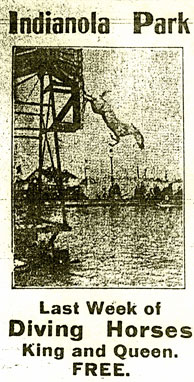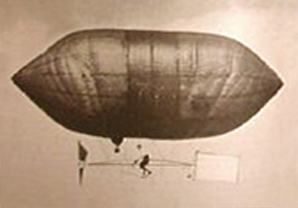
PRETTY GIRLS- Another entertainment that never failed to draw an audience was anything involving pretty girls. One of the reviews Indianola hosted was the Keystone Bathing Beauties from the Keystone Film Company's motion pictures. Another was Lottie Mayer's Moment Musicale in which comely dancers put on a Grecian dance, lightly attired and barefoot in the style of Isadora Duncan, then moved into the pool for the final portion of the performance. The Pearl Diving Nymphs who demonstrated their aquabatic skills and retrieved shiny objects from the depths of the pool also won favor with audiences. |
 |
THE HUMAN BALL OF DEATH- Daredevils and wild stunts were no strangers to Indianola but in August 1917 the park featured an entertainment so wild that the local papers felt obliged to inveigh against it and call for it to be banned. The Human Ball of Death involved a pretty, scantily attired young woman who was encased in a golden ball. The ball rolled down a steep 75 foot incline and through a double loop-the-loop before coming to a stop. Critics argued the stunt was unacceptably dangerous, offended female dignity, and appealed to a base element. |
|
AIRSHIPS- Aeronautics was in its infancy in 1905 and a sure way to gather a crowd was any sort of display having to do with flight. People were fascinated by balloons, airships, airplanes, and their pilots. Indianola exhibited airships numerous times. Visitors to the park had the unique opportunity to inspect the aircraft close up, talk to the pilots and manufacturers, and watch the craft make an ascent. Exhibitors included balloons from Prof. Carl Myers' Frankfort, New York "balloon farm" and the homemade airship of Columbus' famous "boy aviator" Cromwell Dixon. The problem with airship ascents was that they were subject to the vagaries of wind, weather, and mechanical failure. This was dramatically demonstrated on one of Cromwell Dixon's appearances at the park when his airship somehow came untethered, rose, and drifted away to the south. After a mad pursuit through the busy streets of Columbus, Dixon and his crew recaptured the errant airship south of town. |
THE PANAMA CANAL MODEL- On May 4, 1904, the United States began work on the engineering marvel of the age: The Panama Canal. Engineers and laborers battled jungles, swamps, floods, landslides, mountains, and disease to cut from the Atlantic to the Pacific. At the height of construction, the project employed 25,000 men and used 3,000 tons of dynamite a year. The canal was completed in August 1914 after 10 years of effort, tens of millions of dollars in expenditures, and the loss of nearly 6,000 workers' lives. Interest in the project was widespread during its construction and, in that enthusiasm, the park saw an opportunity. In 1909, Indianola unveiled a huge, working, scale model of the Panama Canal. As a park employee lectured on the wonders of the project, visitors watched battleships and freighters enter the canal, pass through the locks, and travel from the Atlantic to the Pacific. When the exhibit opened, hundreds stood in line for a glimpse. Special exhibitions were arranged for children from Columbus City and parochial schools. Parents were urged not to deny their children this one-of-a-kind educational opportunity. The canal model was heavily promoted to state fair attendeees as a not-to-be-missed attraction while they were in town. The model continued to draw visitors for many years. |
|
![]()




